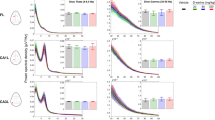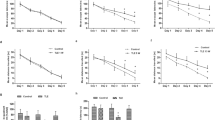Abstract
For many glioblastoma multiforme patients, cognitive deficits are part of the disease process. In this study we attempted to determine the role of synaptic plasticity and glutamate (Glu) in C6 glioma-bearing rats. Male Sprague–Dawley (SD) rats were subjected to tumor implantation in the right caudate putamen nucleus. At 17 days after tumor implantation, animals were exposed to an open field test. The numbers of crossings and rearings were used as measures of exploration processes. An input/output (I/O) curve was first determined using the measurements of field excitatory postsynaptic potential (fEPSP) slope in response to a series of stimulation intensities. The short-term potentiation (STP) and long-term potentiation (LTP) induced by high-frequency stimulation (HFS) in the CA1 region of the contralateral hippocampus to the tumor were recorded. The glutamate and γ-aminobutyric acid (GABA) content of contralateral hippocampus were quantified by high-performance liquid chromatography (HPLC). C6 glioma-bearing rats showed a trend for a rightward shift of input/output relationship and significant deficits in maintenance of STP and LTP. Quantitative analysis by HPLC of glutamate and γ-aminobutyric acid revealed that Glu concentration and Glu/GABA ratio were increased significantly in contralateral hippocampus, suggesting impairment of excitatory and inhibitory synaptic transmission. The results suggest that the neurocognitive deficits in C6 glioma-bearing rats may be mediated via profound changes in neuroplasticity and elevated Glu concentration and Glu/GABA ratio in hippocampus area of the brain.





Similar content being viewed by others
References
Sathornsumetee S, Rich JN (2006) New treatment strategies for malignant gliomas. Expert Rev Anticancer Ther 6:1087–1104
Kayl AE, Meyers CA (2003) Does brain tumor histology influence cognitive function? Neuro Oncol 5:255–260
Taphoorn MJ, Klein M (2004) Cognitive deficits in adult patients with brain tumours. Lancet Neurol 3:159–168
Foster TC (1999) Involvement of hippocampal synaptic plasticity in age-related memory decline. Brain Res Brain Res Rev 30:236–249
Lante F, de Jesus Ferreira MC, Guiramand J, Recasens M, Vignes M (2006) Low-frequency stimulation induces a new form of LTP, metabotropic glutamate (mGlu5) receptor- and PKA-dependent, in the CA1 area of the rat hippocampus. Hippocampus 16:345–360
Quan MN, Tian YT, Xu KH, Zhang T, Yang Z (2010) Post weaning social isolation influences spatial cognition, prefrontal cortical synaptic plasticity and hippocampal potassium ion channels in Wistar rats. Neuroscience 169:214–222
Bliss TV, Lomo T (1973) Long-lasting potentiation of synaptic transmission in the dentate area of the anaesthetized rabbit following stimulation of the perforant path. J Physiol 232:331–356
Bliss TV, Collingridge GL (1993) A synaptic model of memory: long-term potentiation in the hippocampus. Nature 361:31–39
Malenka RC, Nicoll RA (1999) Long-term potentiation–a decade of progress? Science 285:1870–1874
Martin SJ, Grimwood PD, Morris RG (2000) Synaptic plasticity and memory: an evaluation of the hypothesis. Annu Rev Neurosci 23:649–711
Schmid AW, Lynch MA, Herron CE (2009) The effects of IL-1 receptor antagonist on beta amyloid mediated depression of LTP in the rat CA1 in vivo. Hippocampus 19:670–676
Su Z, Han D, Sun B, Qiu J, Li Y, Li M, Zhang T, Yang Z (2009) Heat stress preconditioning improves cognitive outcome after diffuse axonal injury in rats. J Neurotrauma 26:1695–1706
Bao G, Kang L, Li H, Li Y, Pu L, Xia P, Ma L, Pei G (2007) Morphine and heroin differentially modulate in vivo hippocampal LTP in opiate-dependent rat. Neuropsychopharmacology 32:1738–1749
Zhang Y, Cai GE, Yang Q, Lu QC, Li ST, Ju G (2010) Time-dependent changes in learning ability and induction of long-term potentiation in the lithium-pilocarpine-induced epileptic mouse model. Epilepsy Behav 17:448–454
de Oliveira MS, Cechim G, Braganhol E, Santos DG, Meurer L, de Castro CG Jr, Brunetto AL, Schwartsmann G, Battastini AM, Lenz G, Roesler R, Lenz G, Roesler R (2009) Anti-proliferative effect of the gastrin-release peptide receptor antagonist RC-3095 plus temozolomide in experimental glioblastoma models. J Neurooncol 93:191–201
Cao J, Chen N, Xu T, Xu L (2004) Stress-facilitated LTD induces output plasticity through synchronized-spikes and spontaneous unitary discharges in the CA1 region of the hippocampus. Neurosci Res 49:229–239
Leung LS (1980) Behavior-dependent evoked potentials in the hippocampal CA1 region of the rat. I. Correlation with behavior and EEG. Brain Res 198:95–117
Carlsson G, Gullberg B, Hafstrom L (1983) Estimation of liver tumor volume using different formulas—an experimental study in rats. J Cancer Res Clin Oncol 105:20–23
Leong AS, Milios J (1990) Accelerated immunohistochemical staining by microwaves. J Pathol 161:327–334
Kaye AH, Morstyn G, Gardner I, Pyke K (1986) Development of a xenograft glioma model in mouse brain. Cancer Res 46:1367–1373
Grobben B, De Deyn PP, Slegers H (2002) Rat C6 glioma as experimental model system for the study of glioblastoma growth and invasion. Cell Tissue Res 310:257–270
Hasselmo ME (1995) Neuromodulation and cortical function: modeling the physiological basis of behavior. Behav Brain Res 67:1–27
VanElzakker M, Fevurly RD, Breindel T, Spencer RL (2008) Environmental novelty is associated with a selective increase in Fos expression in the output elements of the hippocampal formation and the perirhinal cortex. Learn Mem 15:899–908
Malenka RC, Bear MF (2004) LTP and LTD: an embarrassment of riches. Neuron 44:5–21
Moser MB, Moser EI (2000) Pretraining and the function of hippocampal long-term potentiation. Neuron 26:559–561
Cooke SF, Bliss TV (2006) Plasticity in the human central nervous system. Brain 129:1659–1673
Albensi BC, Oliver DR, Toupin J, Odero G (2007) Electrical stimulation protocols for hippocampal synaptic plasticity and neuronal hyper-excitability: are they effective or relevant? Exp Neurol 204:1–13
Yoon KW (1995) Glutamate effect on synaptic transmission mediates neurotoxicity in dissociated rat hippocampal neurons. Brain Res 669:320–324
Olney JW, Ho OL, Rhee V (1971) Cytotoxic effects of acidic and sulphur containing amino acids on the infant mouse central nervous system. Exp Brain Res 14:61–76
Klegeris A, Walker DG, McGeer PL (1997) Regulation of glutamate in cultures of human monocytic THP-1 and astrocytoma U-373 MG cells. J Neuroimmunol 78:152–161
Behrens PF, Langemann H, Strohschein R, Draeger J, Hennig J (2000) Extracellular glutamate and other metabolites in and around RG2 rat glioma: an intracerebral microdialysis study. J Neurooncol 47:11–22
Marder CP, Buonomano DV (2003) Differential effects of short- and long-term potentiation on cell firing in the CA1 region of the hippocampus. J Neurosci 23:112–121
Choi DW (1988) Glutamate neurotoxicity and diseases of the nervous system. Neuron 1:623–634
Acknowledgments
This work was supported by grants from the National Natural Science Foundation of China (30870827, 31070964), the “111” Project (B08011) and TRPAFAT (10jczdjc19100).
Author information
Authors and Affiliations
Corresponding authors
Rights and permissions
About this article
Cite this article
Wang, Yy., Liu, Sc., Yang, Z. et al. Impaired hippocampal synaptic plasticity in C6 glioma-bearing rats. J Neurooncol 103, 469–477 (2011). https://doi.org/10.1007/s11060-010-0447-7
Received:
Accepted:
Published:
Issue Date:
DOI: https://doi.org/10.1007/s11060-010-0447-7




